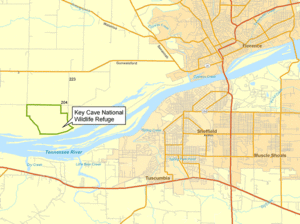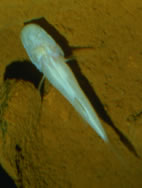Key Cave National Wildlife Refuge facts for kids
Quick facts for kids Key Cave National Wildlife Refuge |
|
|---|---|
|
IUCN Category IV (Habitat/Species Management Area)
|
|
| Location | Lauderdale County, Alabama, United States |
| Nearest city | Florence, Alabama |
| Area | 1,060 acres (4.3 km2) |
| Established | 1997 |
| Visitors | 6000 (in 2005) |
| Governing body | U.S. Fish and Wildlife Service |
| Website | Key Cave NWR |
The Key Cave National Wildlife Refuge is a special protected area in northwestern Alabama. It covers about 1,060 acres (4.3 square kilometers) of land. This refuge is located near the Tennessee River, not far from Florence, Alabama. The U.S. Fish and Wildlife Service manages it.
Even though it doesn't have staff on site, over 6,000 people visit each year! The refuge is looked after by the team at the Wheeler National Wildlife Refuge.
Contents
Exploring the Landscape of Key Cave Refuge
Inside the refuge, there are two important caves: Key Cave and Collier Cave. These caves are about 1.5 miles (2.4 km) apart. Both caves are closed to visitors to protect the wildlife inside. They are located on the northern shore of Pickwick Lake, which is part of the Tennessee River.
The area also has many sinkholes and cave systems. One special feature is a 38-acre (15-hectare) sinkhole lake. These sinkholes and caves help collect groundwater, which is water found underground. This groundwater then flows into the caves. The refuge works hard to keep this underground water clean and free from pollution.
Restoring the Land at Key Cave
The land at Key Cave National Wildlife Refuge used to be heavily farmed. This caused a lot of erosion, which is when soil gets washed away. To fix this, the refuge is working to bring back native plants. They are planting warm season grasses and different kinds of hardwood trees. This helps protect the groundwater that feeds the caves.
About 338 acres (1.4 square kilometers) of land are still used for growing corn and soybeans. But other parts are being restored. For example, 260 acres (1.1 square kilometers) are now covered with native grasses. These include tall grasses like big bluestem and Indiangrass. Also, 122 acres (0.49 square kilometers) of hardwood forest have been planted. These new trees help stop erosion. The refuge also has areas being turned into grasslands or hedgerows, shallow water spots, and 256 acres (1.0 square kilometer) of older hardwood forests with oak and hickory trees.
History of Key Cave National Wildlife Refuge
For a long time, the land that is now Key Cave National Wildlife Refuge was used for farming. Farmers mostly grew cotton here. The refuge gets its name from William Key, who once owned this land. There is even an old cemetery on the refuge called "Key Cemetery."
In 1990, scientists studied the underground water table in the area. They found that the water was being polluted by chemicals from nearby farms. These farms grew cotton, soybeans, corn, and wheat. The pollution was affecting the water system that connected Key Cave and Collier Cave.
To protect the caves, a company called Monsanto sold some land in 1992. This land was in the most risky area for pollution. It was sold to a group called The Conservation Fund. Later, this land was sold to the U.S. Fish and Wildlife Service. This led to the creation of the Key Cave National Wildlife Refuge on January 3, 1997.
Amazing Animals of Key Cave Refuge
Key Cave is a super important home for some very rare animals. One of the most special is the endangered Alabama cavefish (Speoplatyrhinus poulsoni). This fish lives only in caves and is very hard to find. Scientists have only seen about 130 of these fish in Key Cave between 1967 and 1998.
The refuge also protects about 40,000 endangered gray bats (Myotis grisescens). These bats use the cave as a safe place to live. Two types of endangered crayfish also live in the cave: the Phantom cave crayfish (Procambarus pecki) and Cambarus jonesi.
Bird Species at Key Cave Refuge
Key Cave National Wildlife Refuge is also a great place for birds. Many different bird species live here. Some of these include grasshopper sparrows, dickcissels, and northern harriers. You might also spot short-eared owls, loggerhead shrikes, and northern bobwhites. The refuge helps these birds by providing them with safe habitats.
Visiting Key Cave National Wildlife Refuge
The refuge has 2.5 miles (4.0 km) of trails that you can use for hiking and cycling. Remember, Key Cave itself is not open to the public. But there are special viewing platforms nearby. These platforms let you safely watch the amazing bats as they fly out of the cave during the summer evenings. Key Cave NWR is also site #9 on the North Alabama Birding Trail, making it a great spot for birdwatchers!
Images for kids





